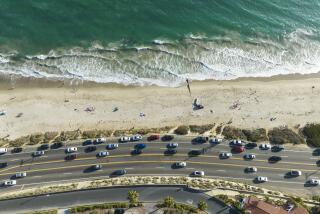Federal Aid Sought in Beach Probe
- Share via
HUNTINGTON BEACH — Hoping to avert what threatens to become an environmental and economic disaster, U.S. and state politicians vowed Thursday to seek federal help to find the source of a sewage leak that has plagued the city most of the summer.
The source of the leak has eluded an array of high-tech sleuthing--from ground-penetrating radar to offshore sonar.
With 4.2 miles of the coast--all of the state beach and the city beach south of Goldenwest Street--now closed to swimmers and surfers, officials and merchants are bracing for what may become a financially disastrous Labor Day weekend. To lure visitors, the city said Thursday that it will lower the beach parking fee to $1 a day, down from $7.
“They can still play on the sand, walk along the pier or on the bicycle trail, and also help support our local businesses,” said Ray Silver, city administrator.
Attendance at Huntington State Beach is down a third this year, said Don Ito, state parks superintendent.
Meanwhile, the cost of searching for the leak has topped $400,000.
“What I’m trying to do is mobilize the government’s agencies to at least consult with local agencies and bring their technical expertise here,” said Rep. Dana Rohrabacher at a news conference Thursday.
The Huntington Beach Republican, himself a surfer, said he has requested help from the Army Corps of Engineers and the Federal Emergency Management Agency. The Coast Guard has offered boats and helicopters, and Los Angeles County has offered laboratory analysis and other help. Also, the National Oceanic and Atmospheric Administration is giving searchers satellite photos that might provide clues about the source of the leak.
Rohrabacher, joined by Assemblyman Scott Baugh (R-Huntington Beach), Mayor Peter Green and county Supervisor Jim Silva, said: “What I have seen so far is a high level of cooperation among local agencies. We have a system in place, but our quandary is: We cannot find the source.”
Ocean water tests Thursday showed a reduction in bacteria levels to within safety standards along most of the beach. But pollution above an acceptable level remained in a three-quarter-mile stretch between Brookhurst and Newland streets. To ensure a safe buffer zone, health officials left in place the yellow police tape cordoning off the entire 4.2-mile stretch.
The closure of a smaller area was ordered July 1 after routine water testing found enterococcus, an indicator of fecal material from mammals, exceeding the state standard of 104 bacteria per 100 milliliters.
Sanitation officials went airborne Thursday night aboard a police helicopter with an infrared camera to try to detect any sewage. Results from the flight should be available today, officials said.
Part of the problem is that the sewage plume does not have a consistent pattern. It is detected, then slowly dissipated by ocean winds and currents.
The plume disappeared for a week but reappeared where it had first been spotted near Newland.
“We have had days where we were well within the standards as far as our samplings are concerned,” said Larry W. Honeybourne of the county Health Care Agency. “But as long as the source is not eliminated, we cannot reopen the beach.”
But pressure is mounting, especially from businesses. At a multi-agency task force meeting Thursday, a representative of the developer of the Waterfront Hilton said the economic toll could be high.
“This beach may not be able to continue to employ our people. In fact, for a lot of people their jobs are on the line, including mine,” said Shawn K. Millbern, senior vice president of the Robert Mayer Corp.
More to Read
Sign up for Essential California
The most important California stories and recommendations in your inbox every morning.
You may occasionally receive promotional content from the Los Angeles Times.










